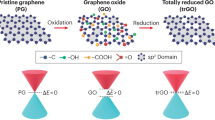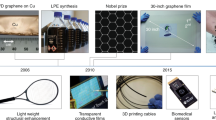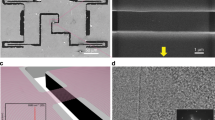Abstract
Graphene is a rapidly rising star on the horizon of materials science and condensed-matter physics. This strictly two-dimensional material exhibits exceptionally high crystal and electronic quality, and, despite its short history, has already revealed a cornucopia of new physics and potential applications, which are briefly discussed here. Whereas one can be certain of the realness of applications only when commercial products appear, graphene no longer requires any further proof of its importance in terms of fundamental physics. Owing to its unusual electronic spectrum, graphene has led to the emergence of a new paradigm of 'relativistic' condensed-matter physics, where quantum relativistic phenomena, some of which are unobservable in high-energy physics, can now be mimicked and tested in table-top experiments. More generally, graphene represents a conceptually new class of materials that are only one atom thick, and, on this basis, offers new inroads into low-dimensional physics that has never ceased to surprise and continues to provide a fertile ground for applications.
This is a preview of subscription content, access via your institution
Access options
Subscribe to this journal
Receive 12 print issues and online access
$259.00 per year
only $21.58 per issue
Buy this article
- Purchase on Springer Link
- Instant access to full article PDF
Prices may be subject to local taxes which are calculated during checkout






Similar content being viewed by others
References
Wallace, P. R. The band theory of graphite. Phys. Rev. 71, 622–634 (1947).
McClure, J. W. Diamagnetism of graphite. Phys. Rev. 104, 666–671 (1956).
Slonczewski, J. C. & Weiss, P. R. Band structure of graphite. Phys. Rev. 109, 272–279 (1958).
Semenoff, G. W. Condensed-matter simulation of a three-dimensional anomaly. Phys. Rev. Lett. 53, 2449–2452 (1984).
Fradkin, E. Critical behavior of disordered degenerate semiconductors. Phys. Rev. B 33, 3263–3268 (1986).
Haldane, F. D. M. Model for a quantum Hall effect without Landau levels: Condensed-matter realization of the 'parity anomaly'. Phys. Rev. Lett. 61, 2015–2018 (1988).
Novoselov, K. S. et al. Electric field effect in atomically thin carbon films. Science 306, 666–669 (2004).
Novoselov, K. S. et al. Two-dimensional atomic crystals. Proc. Natl Acad. Sci. USA 102, 10451–10453 (2005).
Novoselov, K. S. et al. Two-dimensional gas of massless Dirac fermions in graphene. Nature 438, 197–200 (2005).
Zhang, Y., Tan, J. W., Stormer, H. L. & Kim, P. Experimental observation of the quantum Hall effect and Berry's phase in graphene. Nature 438, 201–204 (2005).
Peierls, R. E. Quelques proprietes typiques des corpses solides. Ann. I. H. Poincare 5, 177–222 (1935).
Landau, L. D. Zur Theorie der phasenumwandlungen II. Phys. Z. Sowjetunion 11, 26–35 (1937).
Landau, L. D. & Lifshitz, E. M. Statistical Physics, Part I (Pergamon, Oxford, 1980).
Mermin, N. D. Crystalline order in two dimensions. Phys. Rev. 176, 250–254 (1968).
Venables, J. A., Spiller, G. D. T. & Hanbucken, M. Nucleation and growth of thin films. Rep. Prog. Phys. 47, 399–459 (1984).
Evans, J. W., Thiel, P. A. & Bartelt, M. C. Morphological evolution during epitaxial thin film growth: Formation of 2D islands and 3D mounds. Sur. Sci. Rep. 61, 1–128 (2006).
Stankovich, S. et al. Graphene-based composite materials. Nature 442, 282–286 (2006).
Meyer, J. C. et al. The structure of suspended graphene sheets. Nature (in the press); doi:10.1038/nature05545.
Nelson, D. R., Piran, T. & Weinberg, S. Statistical Mechanics of Membranes and Surfaces (World Scientific, Singapore, 2004).
Partoens, B. & Peeters, F. M. From graphene to graphite: Electronic structure around the K point. Phys. Rev. B 74, 075404 (2006).
Morozov, S. V. et al. Two-dimensional electron and hole gases at the surface of graphite. Phys. Rev. B 72, 201401 (2005).
Zhang, Y., Small, J. P., Amori, M. E. S. & Kim, P. Electric field modulation of galvanomagnetic properties of mesoscopic graphite. Phys. Rev. Lett. 94, 176803 (2005).
Dresselhaus, M. S. & Dresselhaus, G. Intercalation compounds of graphite. Adv. Phys. 51, 1–186 (2002).
Shioyama, H. Cleavage of graphite to graphene. J. Mater. Sci. Lett. 20, 499–500 (2001).
Viculis, L. M., Mack, J. J., & Kaner, R. B. A chemical route to carbon nanoscrolls. Science 299, 1361 (2003).
Horiuchi, S. et al. Single graphene sheet detected in a carbon nanofilm. Appl. Phys. Lett. 84, 2403–2405 (2004).
Krishnan, A. et al. Graphitic cones and the nucleation of curved carbon surfaces. Nature 388, 451–454 (1997).
Land, T. A., Michely, T., Behm, R. J., Hemminger, J. C. & Comsa, G. STM investigation of single layer graphite structures produced on Pt(111) by hydrocarbon decomposition. Surf. Sci. 264, 261–270 (1992).
Nagashima, A. et al. Electronic states of monolayer graphite formed on TiC(111) surface. Surf. Sci. 291, 93–98 (1993).
van Bommel, A. J., Crombeen, J. E. & van Tooren, A. LEED and Auger electron observations of the SiC(0001) surface. Surf. Sci. 48, 463–472 (1975).
Forbeaux, I., Themlin, J.-M. & Debever, J. M. Heteroepitaxial graphite on 6H-SiC(0001): Interface formation through conduction-band electronic structure. Phys. Rev. B 58, 16396–16406 (1998).
Berger, C. et al. Ultrathin epitaxial graphite: 2D electron gas properties and a route toward graphene-based nanoelectronics. J. Phys. Chem. B 108, 19912–19916 (2004).
Berger, C. et al. Electronic confinement and coherence in patterned epitaxial graphene. Science 312, 1191–1196 (2006).
Ohta, T., Bostwick, A., Seyller, T., Horn, K. & Rotenberg, E. Controlling the electronic structure of bilayer graphene. Science 313, 951–954 (2006).
Ohashi, Y., Koizumi, T., Yoshikawa, T., Hironaka, T. & Shiiki, K. Size effect in the in-plane electrical resistivity of very thin graphite crystals. TANSO 235–238 (1997).
Bunch, J. S., Yaish, Y., Brink, M., Bolotin, K. & McEuen, P. L. Coulomb oscillations and Hall effect in quasi-2D graphite quantum dots. Nano Lett. 5, 287–290 (2005).
Ferrari, A. C. et al. Raman spectrum of graphene and graphene layers. Phys. Rev. Lett. 97, 187401 (2006).
Gupta, A., Chen, G., Joshi, P., Tadigadapa, S. & Eklund, P. C. Raman scattering from high-frequency phonons in supported n-graphene layer films. Nano Lett. 6, 2667–2673 (2006).
Divigalpitiya, W. M. R., Frindt, R. F. & Morrison, S. R. Inclusion systems of organic molecules in restacked single-layer molybdenum disulfide. Science 246, 369–371 (1989).
Klein, A., Tiefenbacher, S., Eyert, V., Pettenkofer, C. & Jaegermann, W. Electronic band structure of single-crystal and single-layer WS2: Influence of interlayer van der Waals interactions. Phys. Rev. B 64, 205416 (2001).
Schedin, F. et al. Detection of individual gas molecules by graphene sensors. Preprint at http://arxiv.org/abs/cond-mat/0610809 (2006).
Novoselev, K. S. et al. Room-temperature quantum Hall effect in graphene. Science (in the press); doi:10.1126/science.1137201.
Schakel, A. M. J. Relativistic quantum Hall effect. Phys. Rev. D 43, 1428–1431 (1991).
González, J., Guinea, F. & Vozmediano, M. A. H. Unconventional quasiparticle lifetime in graphite. Phys. Rev. Lett. 77, 3589–3592 (1996).
Gorbar, E. V., Gusynin, V. P., Miransky, V. A. & Shovkovy, I. A. Magnetic field driven metal-insulator phase transition in planar systems. Phys. Rev. B 66, 045108 (2002).
Katsnelson, M. I. Zitterbewegung, chirality, and minimal conductivity in graphene. Eur. Phys. J. B 51, 157–160 (2006).
Katsnelson, M. I, Novoselov, K. S. & Geim, A. K. Chiral tunnelling and the Klein paradox in graphene. Nature Phys 2, 620–625 (2006).
Tworzydlo, J., Trauzettel, B., Titov, M., Rycerz, A. & Beenakker, C. W. J. Quantum-limited shot noise in graphene. Phys. Rev. Lett. 96, 246802 (2006).
Zawadzki, W. Electron transport phenomena in small-gap semiconductors. Adv. Phys. 23, 435–522 (1974).
Luk'yanchuk, I. A. & Kopelevich, Y. Dirac and normal fermions in graphite and graphene: Implications of the quantum Hall effect. Phys. Rev. Lett. 97, 256801 (2006).
Zhou, S. Y. et al. First direct observation of Dirac fermions in graphite. Nature Phys. 2, 595–599 (2006).
Zheng, Y. & Ando, T. Hall conductivity of a two-dimensional graphite system. Phys. Rev. B 65, 245420 (2002).
Gusynin, V. P. & Sharapov, S. G. Unconventional integer quantum Hall effect in graphene Phys. Rev. Lett. 95, 146801 (2005).
Peres, N. M. R., Guinea, F. & Castro Neto, A. H. Electronic properties of disordered two-dimensional carbon. Phys. Rev. B 73, 125411 (2006).
MacDonald, A. H. Quantized Hall conductance in a relativistic two-dimensional electron gas. Phys. Rev. B 28, 2235–2236 (1983).
Novoselov, K. S. et al. Unconventional quantum Hall effect and Berry's phase of 2π in bilayer graphene. Nature Phys. 2, 177–180 (2006).
Mikitik, G. P. & Sharlai, Yu.V. Manifestation of Berry's phase in metal physics. Phys. Rev. Lett. 82, 2147–2150 (1999).
McCann, E. & Fal'ko, V. I. Landau-level degeneracy and quantum Hall effect in a graphite bilayer. Phys. Rev. Lett. 96, 086805 (2006).
McCann, E. Asymmetry gap in the electronic band structure of bilayer graphene. Phys. Rev. B 74, 161403 (2006).
Castro, E. V. et al. Biased bilayer graphene: semiconductor with a gap tunable by electric field effect. Preprint at http://arxiv.org/abs/cond-mat/0611342 (2006).
Lee, P. A. Localized states in a d-wave superconductor. Phys. Rev. Lett. 71, 1887–1890 (1993).
Ludwig, A. W. W., Fisher, M. P. A., Shankar, R. & Grinstein, G. Integer quantum Hall transition: An alternative approach and exact results. Phys. Rev. B 50, 7526–7552 (1994).
Ziegler, K. Delocalization of 2D Dirac fermions: the role of a broken symmetry. Phys. Rev. Lett. 80, 3113–3116 (1998).
Ostrovsky, P. M., Gornyi, I. V. & Mirlin, A. D. Electron transport in disordered graphene. Phys. Rev. B 74, 235443 (2006).
Nomura, K. & MacDonald, A. H. Quantum transport of massless Dirac fermions in graphene. Preprint at http://arxiv.org/abs/cond-mat/0606589 (2006).
Nilsson, J., Castro Neto, A. H., Guinea, F. & Peres, N. M. R. Electronic properties of graphene multilayers. Preprint at http://arxiv.org/abs/cond-mat/0604106 (2006).
Morozov, S. V. et al. Strong suppression of weak localization in graphene. Phys. Rev. Lett. 97, 016801 (2006).
Aleiner, I. L. & Efetov, K. B. Effect of disorder on transport in graphene. Phys. Rev. Lett. 97, 236801 (2006).
Das Sarma, S., Hwang, E. H., Tse, W. K. Is graphene a Fermi liquid? Preprint at http://arxiv.org/abs/cond-mat/0610581 (2006).
McCann, E. et al. Weak localisation magnetoresistance and valley symmetry in graphene. Phys. Rev. Lett. 97, 146805 (2006).
Morpurgo, A. F. & Guinea, F. Intervalley scattering, long-range disorder, and effective time reversal symmetry breaking in graphene. Phys. Rev. Lett. 97, 196804 (2006).
Rycerz, A., Tworzydlo, J. & Beenakker, C. W. J. Anomalously large conductance fluctuations in weakly disordered graphene. Preprint at http://arxiv.org/abs/cond-mat/0612446 (2006).
Nomura, K. & MacDonald, A. H. Quantum Hall ferromagnetism in graphene. Phys. Rev. Lett. 96, 256602 (2006).
Yang, K., Das Sarma, S. & MacDonald, A. H. Collective modes and skyrmion excitations in graphene SU(4) quantum Hall ferromagnets. Phys. Rev. B 74, 075423 (2006).
Apalkov, V. M. & Chakraborty, T. The fractional quantum Hall states of Dirac electrons in graphene. Phys. Rev. Lett. 97, 126801 (2006).
Khveshchenko, D. V. Composite Dirac fermions in graphene. Preprint at http://arxiv.org/abs/cond-mat/0607174 (2006).
Alicea, J. & Fisher, M. P. A. Graphene integer quantum Hall effect in the ferromagnetic and paramagnetic regimes, Phys. Rev. B 74, 075422 (2006).
Khveshchenko, D. V. Ghost excitonic insulator transition in layered graphite. Phys. Rev. Lett. 87, 246802 (2001).
Abanin, D. A., Lee, P. A. & Levitov, L. S. Spin-filtered edge states and quantum Hall effect in graphene. Phys. Rev. Lett. 96, 176803 (2006).
Toke, C., Lammert, P. E., Crespi, V. H. & Jain, J. K. Fractional quantum Hall effect in graphene. Phys. Rev. B 74, 235417 (2006).
Zhang, Y. et al. Landau-level splitting in graphene in high magnetic fields. Phys. Rev. Lett. 96, 136806 (2006).
Schliemann, J., Loss, D. & Westervelt, R. M. Zitterbewegung of electronic wave packets in III-V zinc-blende semiconductor quantum wells. Phys. Rev. Lett. 94, 206801 (2005).
Topinka, M. A., Westervelt, R. M. & Heller, E. J. Imaging electron flow. Phys. Today 56, 47–53 (2003).
Cortijo, A. & Vozmediano, M. A. H. Effects of topological defects and local curvature on the electronic properties of planar graphene. Nucl. Phys. B 763, 293–308 (2007).
Nakada, K., Fujita, M., Dresselhaus, G. & Dresselhaus, M. S. Edge state in graphene ribbons: Nanometer size effect and edge shape dependence. Phys. Rev. B 54, 17954–17961 (1996).
Brey, L. & Fertig, H. A. Electronic states of graphene nanoribbons. Phys. Rev. B 73, 235411 (2006).
Son, Y. W, Cohen, M. L. & Louie, S. G. Energy gaps in graphene nanoribbons Phys. Rev. Lett. 97, 216803 (2006).
Tilke, A. T., Simmel, F. C., Blick, R. H, Lorenz, H. & Kotthaus, J. P. Coulomb blockade in silicon nanostructures. Prog. Quantum Electron. 25, 97–138 (2001).
Takahashi, Y., Ono, Y., Fujiwara, A. & Inokawa, H. Silicon single-electron devices. J. Phys. Condens. Matter 14, R995–R1033 (2002).
Tseng, A. A., Notargiacomo A. & Chen T. P. Nanofabrication by scanning probe microscope lithography: A review. J. Vac. Sci. Tech. B 23, 877–894 (2005).
Hill, E. W., Geim, A. K., Novoselov, K., Schedin, F. & Blake, P. Graphene spin valve devices. IEEE Trans. Magn. 42, 2694–2696 (2006).
Heersche, H. B., Jarillo-Herrero, P., Oostinga, J. B., Vandersypen, L. M. K. & Morpurgo, A. F. Bipolar supercurrent in graphene. Nature (in the press); doi:10.1038/nature05555.
Sofo, O., Chaudhari, A. & Barber, G. D. Graphane: a two-dimensional hydrocarbon. Preprint at http://arxiv.org/abs/cond-mat/0606704 (2006).
Acknowledgements
We are most grateful to Irina Grigorieva, Alberto Morpurgo, Uli Zeitler, Antonio Castro Neto and Allan MacDonald for many useful comments that helped to improve this review. The image of crumpled graphene on the cover of this issue was kindly provided by Jannik Meyer. The work was supported by EPSRC (UK), the Royal Society and the Leverhulme trust.
Author information
Authors and Affiliations
Corresponding authors
Rights and permissions
About this article
Cite this article
Geim, A., Novoselov, K. The rise of graphene. Nature Mater 6, 183–191 (2007). https://doi.org/10.1038/nmat1849
Issue Date:
DOI: https://doi.org/10.1038/nmat1849
This article is cited by
-
Ultra-wideband terahertz fingerprint enhancement sensing and inversion model supported by single-pixel reconfigurable graphene metasurface
PhotoniX (2024)
-
Graphene nanowalls formation investigated by Electron Energy Loss Spectroscopy
Scientific Reports (2024)
-
Stoner instability-mediated large magnetoelectric effects in 2D stacking electrides
npj Computational Materials (2024)
-
Critical assessment of G0W0 calculations for 2D materials: the example of monolayer MoS2
npj Computational Materials (2024)
-
Washable and Multifunctional Electronic Textiles Via In Situ Lamination for Personal Health Care
Advanced Fiber Materials (2024)



